Exploring Core Features and Components of Apache Camel
Hello friends! In our previous discussion, we delved into the integration of Apache Camel with Quarkus, demonstrating how to craft real-world applications using Apache Camel. As we continue our series, we aim to take a deep dive into the crucial components and the intrinsic details of Apache Camel.
Enterprise Integration Patterns
At its core, Apache Camel is structured around the concepts introduced in the Enterprise Integration Patterns (EIP) book by Gregor Hohpe and Bobby Woolf. This book outlines numerous patterns that have become standardizations for designing and documenting robust integration solutions across enterprise applications or systems. Here’s an overview of some pivotal patterns utilised within Apache Camel:
- Aggregator
The Aggregator pattern(Figure 1) is essential for collecting and consolidating related messages into a cohesive single message, facilitating comprehensive processing. It acts as a specialized filter, accumulating correlated messages until a complete set of data is received, at which point it publishes an aggregated output for further processing.

Figure 1 – Aggregator Pattern (enterpriseintegrationpatterns.com)
- Content-Based Router
This pattern(Figure 2) dynamically routes messages based on their content to appropriate receivers. Routing decisions can depend on various message attributes such as field presence or specific field values.

Figure 2 – Content-Based Router pattern (enterpriseintegrationpatterns.com)
- Dynamic Router
The Dynamic Router(Figure 3) facilitates routing decisions made at runtime, adapting dynamically based on rules defined externally or through user input, supporting modern service-oriented architectures.
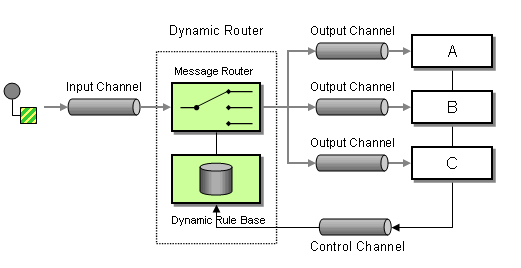
Figure 3 – Dynamic Router pattern (enterpriseintegrationpatterns.com)
- Message Filter
A Message Filter(Figure 4) directs messages to an output channel or discards them based on specified criteria, ensuring that only messages meeting certain conditions are processed further.

Figure 4 – Message Filter pattern (enterpriseintegrationpatterns.com)
- Process Manager
This pattern(Figure 5) orchestrates the sequence of steps in a business process, handling both the execution order and any occurring exceptions. It underpins complex workflows where sequential processing and error management are critical.
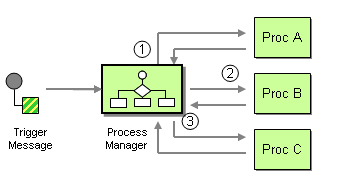
Figure 5 – Process Manager pattern (enterpriseintegrationpatterns.com)
- Normalizer
The Normalizer pattern(Figure 6) is a critical tool in Apache Camel that addresses the challenges of message format discrepancies among different systems. It takes incoming messages in various formats and converts them into a standardized format before further processing, ensuring consistency across the data handling pipeline. This pattern is particularly beneficial in environments where messages originate from diverse sources with varying formats.
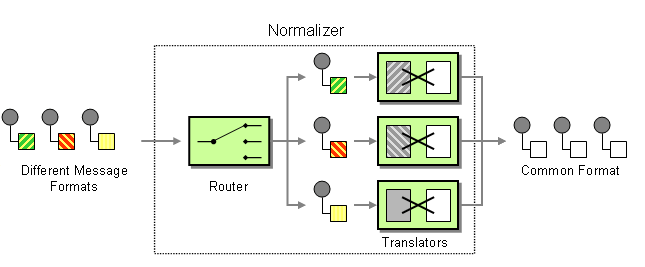
Figure 6 – Normalizer pattern (enterpriseintegrationpatterns.com)
- Splitter
Handling complex messages composed of multiple data items is streamlined by the Splitter pattern(Figure 7). This pattern efficiently divides a compound message into its constituent elements, allowing each element to be processed independently. This is immensely useful in scenarios where different parts of a message need to be routed or processed differently based on their individual characteristics.

Figure 7 – Splitter pattern (enterpriseintegrationpatterns.com)
I have to mention that these are just a few of the patterns that are used in Apache Camel. There are many more patterns that are used in Apache Camel. But I consider these patterns to be the most important ones.
Camel Fundamentals
At its essence, the Apache Camel framework is centered around a powerful routing engine, or more accurately, a routing-engine builder. This engine empowers developers to devise bespoke routing rules, determine which sources to accept messages from, and define how those messages should be processed and dispatched to various destinations. Apache Camel supports the definition of complex routing rules through an integration language similar to those found in intricate business processes.
One of the cardinal principles of Camel is its data-agnostic nature. This flexibility is crucial as it allows developers to interact with any type of system without the strict requirement of transforming data into a predefined canonical format. The ability to handle diverse data forms seamlessly is what makes Camel a versatile tool in the toolkit of any system integrator.
Message
In the realm of Apache Camel, messages are the fundamental entities that facilitate communication between systems via messaging channels. These components are illustrated in (Figure 8). During the course of a route’s execution, messages can undergo various transformations—they can be altered, duplicated, or entirely replaced depending on the specific needs of the process. Messages inherently flow uni-directionally from a sender to a receiver and comprise several components:
-
Body (Payload): The main content of the message.
-
Headers: Metadata associated with the message which can include keys and their respective values.
-
Attachments: Optional files that can be sent along with the message.

Figure 8 – Apache Camel Message structure
Messages in Apache Camel are uniquely identified by an identifier of type java.lang.String. The uniqueness of this identifier is enforced by the message
creator and is dependent on the protocol used, though the format itself is not standardized. For protocols lacking a unique message identification scheme,
Camel employs its own ID generator.
Headers in a Camel message serve as key-value pairs containing metadata such as sender identifiers, hints about content encoding, authentication data, and more.
Each header name is a unique, case-insensitive string, while the value can be any object (java.lang.Object), reflecting Camel’s flexible handling of header types. All headers are stored within the message as a map.
Additionally, messages may include optional attachments, commonly utilized in contexts involving web services and email transactions. The body of the message,
also of type java.lang.Object, is versatile, accommodating any form of content. This flexibility mandates that the application designer ensures content
comprehensibility across different systems. To aid in this, Camel provides various mechanisms, including automatic type conversion when necessary,
to transform data into a compatible format for both sender and receiver, facilitating seamless data integration across diverse environments.
Exchange
In Apache Camel, an Exchange is a pivotal message container that navigates data through a Camel route. As illustrated in (Figure 9), it encapsulates a
message, supporting its transformation and processing through a series of predefined steps within a Camel route. The Exchange implements the following
org.apache.camel.Exchange interface.
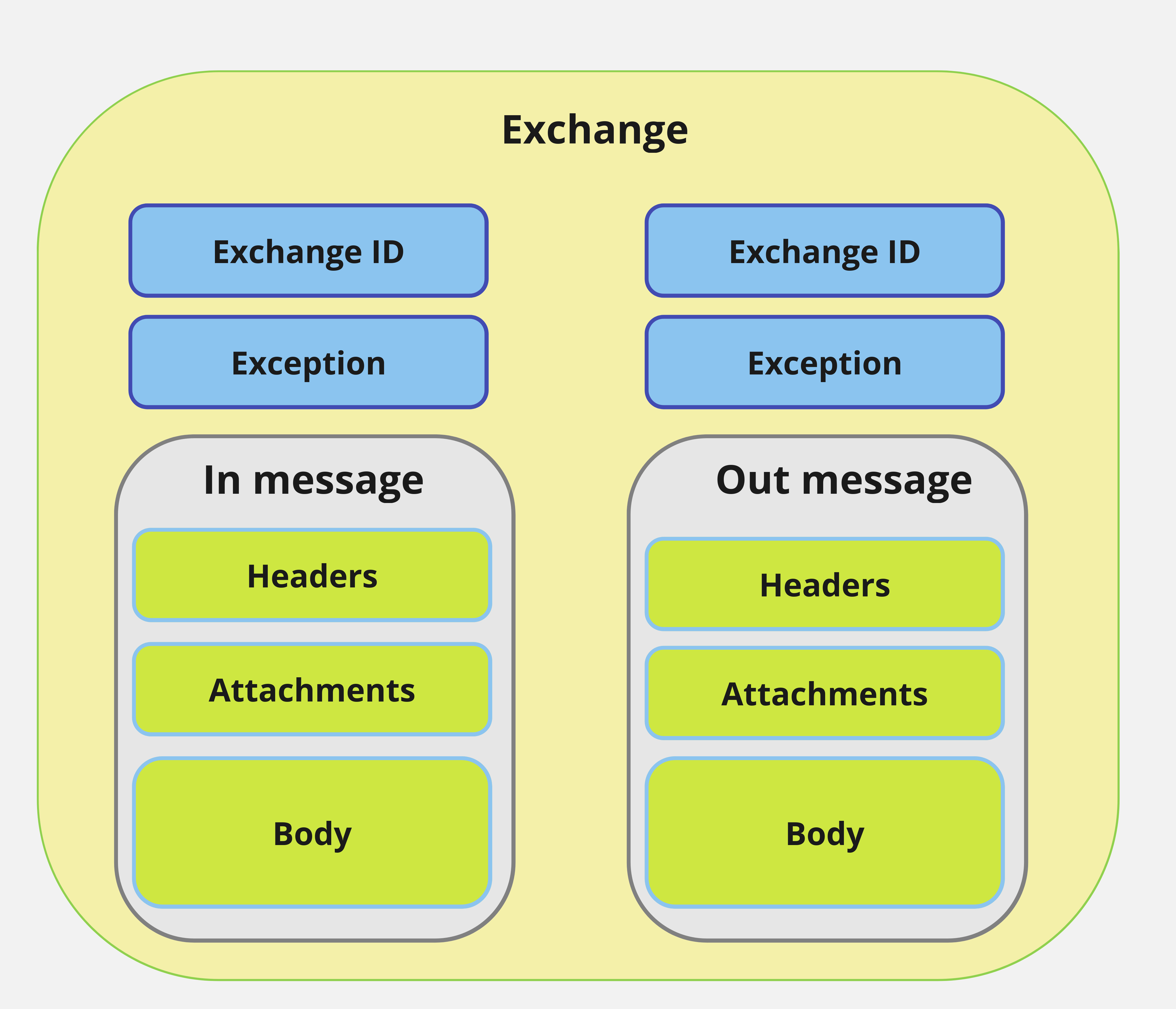
Figure 9 – An Apache Camel exchange
The Exchange is designed to accommodate different styles of messaging, particularly emphasizing the request-reply pattern. It is robust enough to carry information about faults or errors, should exceptions arise during the processing of a message.
-
Exchange ID: This is a unique identifier for the exchange, automatically generated by Camel to ensure traceability..
-
Message Exchange Pattern MEP: Pecifies the messaging style, either
InOnlyorInOut. ForInOnly, the transaction involves only the incoming message. ForInOut, an additional outgoing message (Out Message) exists to relay responses back to the initiator. -
Exception - The Exchange captures exceptions occurring during routing, centralizing error management for easy handling and mitigation.
-
Body: Each message (In and Out) contains a payload of type
java.lang.Object, allowing for diverse content types. -
Headers: Stored as a map, headers include key-value pairs associated with the message, carrying metadata such as routing cues, authentication keys, and other contextual information.
-
Properties: Similar to headers but enduring for the entirety of the exchange, properties hold global-level data pertinent throughout the message processing lifecycle.
-
In message: The foundational component, this mandatory element encapsulates incoming request data from inbound channels.
-
Out message: An optional component that exists in
InOutexchanges, carrying the response data to an outbound channel.
In Apache Camel, an Exchange is a message container which carries the data through a Camel route. It encapsulates a message and allows it to be
transformed and processed across a series of processing steps defined in a Camel route. An Exchange also facilitates the pattern of request-reply messaging
and might carry fault or error information if exceptions occur during message processing.
Camel Context
The Apache Camel Context is an essential element within Apache Camel, serving as the core framework that orchestrates the integration framework’s functionality. It is where the routing rules, configurations, components, and additional integration elements converge. The Camel Context(Figure 10) initializes, configures, and oversees the lifecycle of all components and routes it contains.
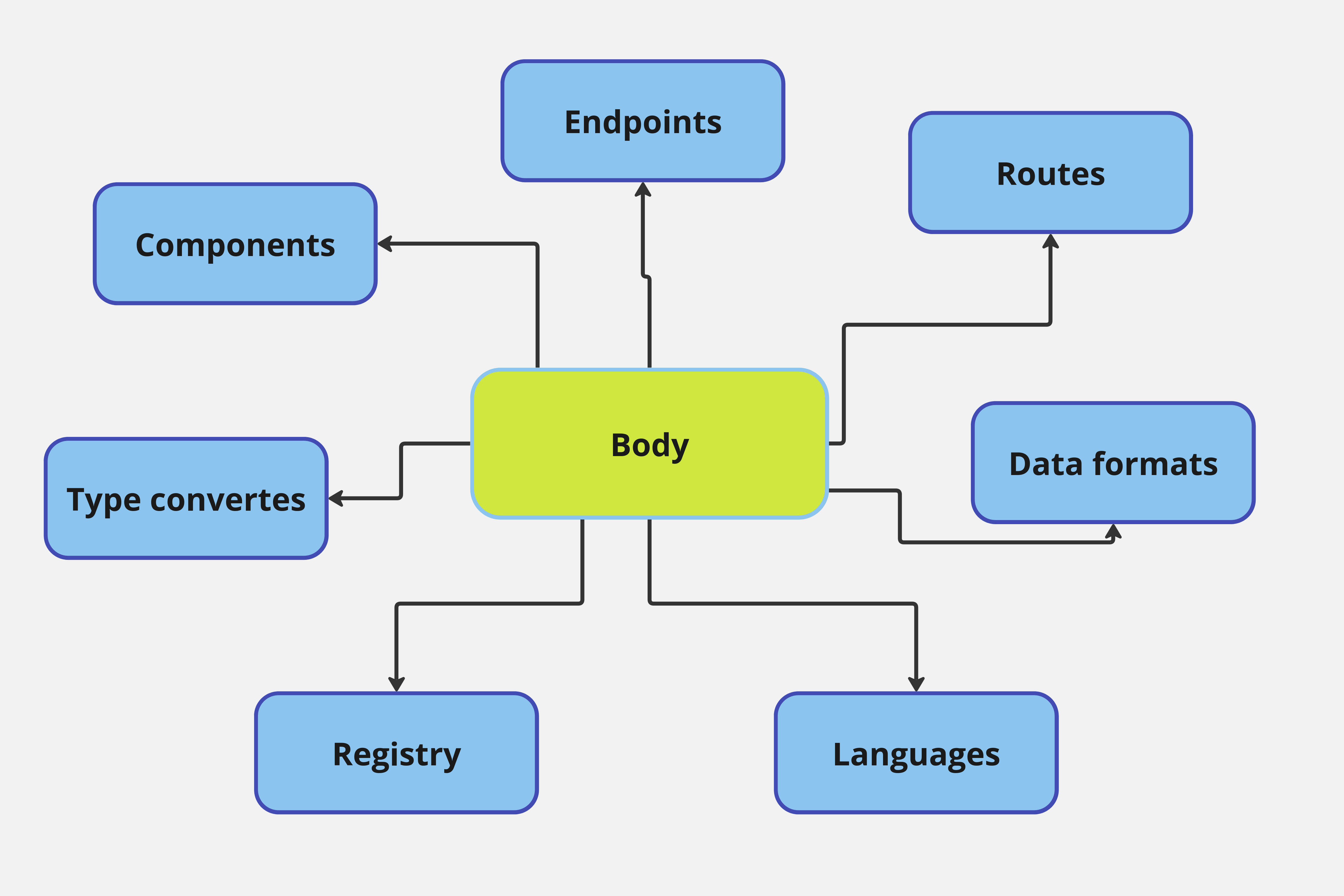
Figure 10 – Apache Camel context
Within the Camel Context, the following critical operations are facilitated:
-
Loading Components and Data Formats: This involves the initialization and availability management of components and data formats used across various routes.
-
Configuring Routes: It provides a mechanism to define the paths that messages follow, including the rules for how messages are processed and mediated across different endpoints.
-
Starting and Stopping Routes: The Camel Context manages the activation and deactivation of routes, ensuring these operations are performed in a thread-safe manner.
-
Error Handling: Implements centralized error-handling mechanisms that can be utilised across all routes within the context.
-
Managing Resources: It ensures efficient management of resources like thread pools or connections, releasing them appropriately when not required anymore.
The Camel Context can be configured either programmatically or declaratively. For instance, in a Java-based setup:
1import org.apache.camel.CamelContext;
2import org.apache.camel.impl.DefaultCamelContext;
3
4public class MainApp {
5 public static void main(String[] args) {
6 CamelContext camelContext = new DefaultCamelContext();
7 try {
8 // Add routes, components, etc.
9 camelContext.start();
10 Thread.sleep(10000);
11 } catch (Exception e) {
12 e.printStackTrace();
13 } finally {
14 try {
15 camelContext.stop();
16 } catch (Exception e) {
17 // Handle exception
18 }
19 }
20 }
21}
For environments like Quarkus, the Camel Context is typically retrieved and managed as follows:
1@Inject CamelContext context;
2
3if (context.isStarted()) {
4 context.getRouteController().startRoute("start_route");
5}
When leveraging Quarkus, the Camel Context is automagically provisioned and managed:
1@ApplicationScoped
2public class DemoRoute extends RouteBuilder {
3
4 @Override
5 public void configure() throws Exception {
6
7 from("direct:start_route")
8 .log("Starting route: ${routeId}, headers: ${headers}")
9 .setHeader("header_abc", constant("header_value"))
10 .to("direct:route_1")
11 .to("direct:route_3");
12 }
13}
Endpoints
In Apache Camel, endpoints represent the interfaces for connecting the Camel application with external systems or services. They are the points at which routes either begin (consume) or end (produce).
Some common types of endpoints include:
- A Camel file endpoint can be used to read from and write to files in a directory.
1// Route to read files from the directory "input" and move processed files to "output"
2from("file:input?move=processed")
3 .to("file:output");
- HTTP endpoints are used for integrating with HTTP services.
1// Route to consume data from an HTTP service
2from("timer:foo?period=60000")
3 .to("http://example.com/api/data")
4 .to("log:result");
- Direct and SEDA
Both
directandsedaare used for in-memory synchronous and asynchronous message queuing respectively within Camel.
1// Using direct for synchronous call
2from("direct:start")
3 .to("log:info");
Routes
Routes in Camel define the message flow between endpoints, incorporating a series of processors or transformations. They are crucial for constructing the processing logic within a Camel application.
Here’s an example demonstrating a series of interconnected routes:
1@ApplicationScoped
2public class DemoRoute extends RouteBuilder {
3
4 @Override
5 public void configure() throws Exception {
6
7 from("direct:start_route")
8 .log("Starting route: ${routeId}, headers: ${headers}")
9 .setHeader("header_abc", constant("header_value"))
10 .to("direct:route_1")
11 .to("direct:route_3");
12
13 from("direct:route_1")
14 .log("Starting route_1: ${routeId}, headers: ${headers}, thread: ${threadName}")
15 .process(
16 exchange -> {
17 exchange.getIn().setHeader("header_abc", "UPDATED_HEADER_VALUE");
18 })
19 .to("direct:route_2");
20
21 from("direct:route_2")
22 .log("Starting route_2: ${routeId}, headers: ${headers}, thread: ${threadName}");
23 }
24}
Here the first route starts from the direct:start_route endpoint, logs the routeId and headers, set the new header with key: header_abc, and then
forwards the message to the next route direct:route_1. The second route logs the routeId, headers, and the thread name, and then forwards the message to
the next route direct:route_2. The third route logs the routeId, headers, and the thread name.
Conclusion
n this detailed exploration of Apache Camel, we have traversed the core concepts and essential components that make it an indispensable tool in the realm of enterprise integration. Beginning with a thorough examination of Enterprise Integration Patterns (EIPs), we understood how Camel utilizes patterns like Aggregators, Splitters, and Normalizers to address common integration challenges effectively.
Further, we delved into the architectural fundamentals of Camel, highlighting its versatile routing capabilities, flexible message model, and the pivotal role of the Camel Context in managing and orchestrating these elements. We also covered practical aspects, demonstrating how routes are defined and managed, along with a look at various endpoint types that facilitate communication with external systems.